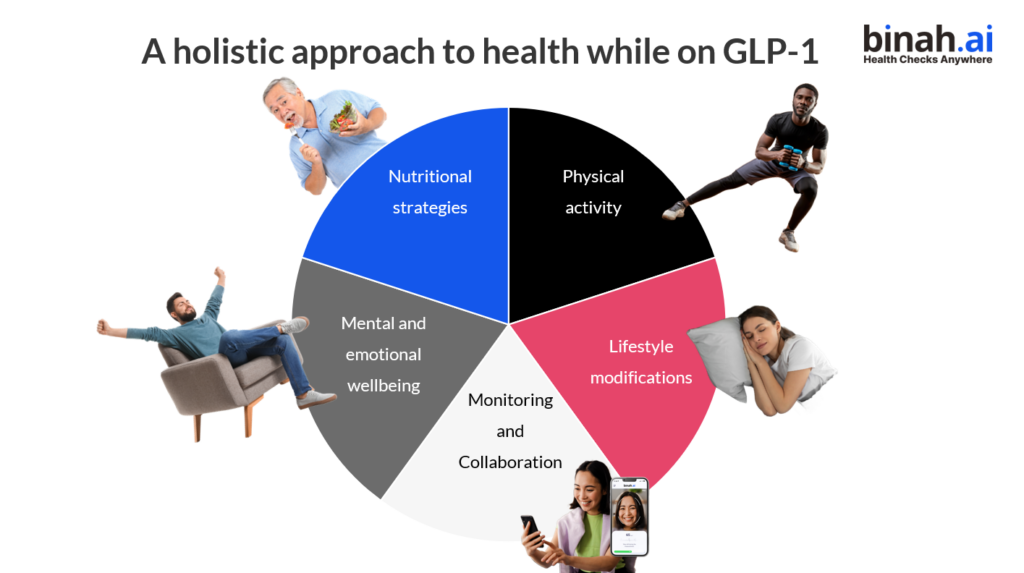GLP-1s and Wellness Programs: Navigating the Shift to Lasting Health
Rethinking Wellness Programs in the Age of GLP-1 Medications
The rise of GLP-1 medications like Ozempic and Wegovy has dramatically shifted the landscape of weight management. Initially developed to manage diabetes, these medications have shown such effective results in reducing appetite and supporting weight loss that they’ve become sought-after solutions for obesity treatment. However, this surge in popularity poses a challenge to traditional wellness programs. As the conversation around weight loss changes, so must the strategies used to promote long-term health.
How GLP-1 Medications Work
Originally developed to manage diabetes, GLP-1 medications mimic the effects of glucagon-like peptide-1 (GLP-1), a hormone that regulates blood sugar and appetite. By slowing gastric emptying and enhancing feelings of fullness, GLP-1s help users consume fewer calories, leading to weight loss. They also improve insulin sensitivity and reduce glucose absorption, making them effective for both diabetes management and obesity treatment.
The Power and Pitfalls of GLP-1s
GLP-1 medications have proven effective in influencing appetite control and glucose metabolism, with many users even losing up to 18% of their body weight. However, the medication comes with its own set of challenges.
For some individuals, taking GLP-1s results in consuming fewer calories, but without addressing underlying lifestyle changes. This can lead to unhealthy eating patterns. Fewer calories may mean fewer nutrients, less balanced meals, and a reliance on calorie-dense, nutrient-poor foods. Essentially, some individuals may end up eating too little, yet still poorly.
It’s also common for individuals to experience a plateau with the medication’s efficacy, and most are advised to stay on it for life to avoid weight regain. However, many patients struggle with adherence due to side effects or challenges in managing injections, with studies showing that up to 35% discontinue use within three months, increasing to 50% within a year.
Why Lifestyle Changes Matter with GLP-1s
To help address the challenges of GLP-1s and optimize their benefits, it’s critical to help users develop healthy lifestyle habits. Complementing GLP-1s with lifestyle changes can help with:
- Enhanced weight loss and maintenance: Combining GLP-1 medications with calorie control and regular exercise leads to significantly greater weight loss and helps counteract metabolic slowdowns. In fact, clinical trials showed that participants who combined GLP-1s with exercise lost an average of 21 pounds, compared to 15 pounds with medication alone.
- Prevention of weight regain: Weight regain is common after discontinuing GLP-1 medications. Long-term lifestyle habits, including healthy eating and activity, help sustain weight loss after stopping medication.
- Improved cardiometabolic health: Regular physical activity and balanced nutrition enhance the medication’s ability to regulate heart health and reduce the risk of heart-related events.
- Reduction of side effects: Eating smaller meals, staying hydrated, and avoiding high-fat foods can minimize the medication’s gastrointestinal side effects like nausea and acid reflux.
- Sustainability beyond medication: Gradual lifestyle adaptation ensures smoother transitions off GLP-1 medications and minimizes weight rebound.
Adapting Wellness Programs to the GLP-1 Revolution
With GLP-1s reshaping weight management, wellness programs must evolve. The focus can no longer be solely on weight loss, it needs to expand to sustaining long-term health. This means addressing nutritional education, helping participants make the most of the smaller portions they consume. It means reinforcing the importance of physical activity, regardless of appetite or weight.
Wellness programs should emphasize comprehensive health monitoring, including tracking blood pressure, glucose levels, and heart health. Tools like Binah.ai’s health monitoring solutions can support this by offering accessible, data-driven insights that go beyond the scale.

The Shift from Weight Loss to Health Maintenance
Ultimately, the widespread use of GLP-1s is an opportunity to reframe wellness efforts. Rather than focusing on the numbers on a scale, the aim should be to promote a lifestyle that prioritizes nutrient-rich eating, regular movement, and overall wellbeing. Employers and health providers must consider this shift, designing programs that nurture sustainable, health-focused habits, not just weight reduction.
While GLP-1s are powerful tools, they are not a substitute for long-term health. The goal should be to leverage the benefits of these medications while cultivating lasting, positive habits that contribute to lifelong wellness.
Enhancing GLP-1 Support with Binah.ai’s Health Monitoring
Binah.ai’s health monitoring technology helps insurers, healthcare providers, and wellness companies support lasting lifestyle changes and health engagement with real-time insights into key health indicators, enabling data-driven support for individuals on GLP-1s. With Binah.ai’s smartphone-based health monitoring technology, payers and providers can enable individuals to measure and monitor health risks, vital signs, stress levels, and even take bloodless blood tests, all using just their smartphone camera or a wearable device. By integrating regular health tracking, organizations can help users optimize their nutrition, exercise, and overall wellbeing, ensuring long-term success beyond medication use.
To learn more about how Binah.ai supports lasting lifestyle changes for individuals on GLP-1s, watch our on-demand webinar, The GLP-1 Revolution: Losing Weight is Easy, Keeping Healthy is the Challenge.

 close
close





